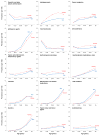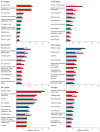Age and sex patterns of drug prescribing in a defined American population
- PMID: 23790544
- PMCID: PMC3754826
- DOI: 10.1016/j.mayocp.2013.04.021
Age and sex patterns of drug prescribing in a defined American population
Abstract
Objective: To describe the age and sex patterns of drug prescribing in Olmsted County, Minnesota.
Patients and methods: Population-based drug prescription records for the Olmsted County population in 2009 were obtained using the Rochester Epidemiology Project medical records linkage system (n=142,377). Drug prescriptions were classified using RxNorm codes and were grouped using the National Drug File-Reference Terminology.
Results: Overall, 68.1% of the population (n=96,953) received a prescription from at least 1 drug group, 51.6% (n=73,501) received prescriptions from 2 or more groups, and 21.2% (n=30,218) received prescriptions from 5 or more groups. The most commonly prescribed drug groups in the entire population were penicillins and β-lactam antimicrobials (17%; n=23,734), antidepressants (13%; n=18,028), opioid analgesics (12%; n=16,954), antilipemic agents (11%; n=16,082), and vaccines/toxoids (11%; n=15,918). However, prescribing patterns differed by age and sex. Vaccines/toxoids, penicillins and β-lactam antimicrobials, and antiasthmatic drugs were most commonly prescribed in persons younger than 19 years. Antidepressants and opioid analgesics were most commonly prescribed in young and middle-aged adults. Cardiovascular drugs were most commonly prescribed in older adults. Women received more prescriptions than men for several drug groups, in particular for antidepressants. For several drug groups, use increased with advancing age.
Conclusion: This study provides valuable baseline information for future studies of drug utilization and drug-related outcomes in this population.
Copyright © 2013 Mayo Foundation for Medical Education and Research. Published by Elsevier Inc. All rights reserved.
Conflict of interest statement
Figures


Similar articles
-
Controlled Substance Prescribing Patterns--Prescription Behavior Surveillance System, Eight States, 2013.MMWR Surveill Summ. 2015 Oct 16;64(9):1-14. doi: 10.15585/mmwr.ss6409a1. MMWR Surveill Summ. 2015. PMID: 26469747
-
Opioid Prescribing Behaviors - Prescription Behavior Surveillance System, 11 States, 2010-2016.MMWR Surveill Summ. 2020 Jan 31;69(1):1-14. doi: 10.15585/mmwr.ss6901a1. MMWR Surveill Summ. 2020. PMID: 31999681 Free PMC article.
-
Opioid Prescribing Patterns and Patient Outcomes by Prescriber Type in the Oregon Prescription Drug Monitoring Program.Pain Med. 2018 Dec 1;19(12):2481-2486. doi: 10.1093/pm/pnx283. Pain Med. 2018. PMID: 29155988 Free PMC article.
-
Sex Differences in Cardiovascular Management: A Call for Better Acknowledgment-Part 1 Pharmacological Differences in Women and Men; How Relevant Are They?Am J Ther. 2024 May-Jun 01;31(3):e237-e245. doi: 10.1097/MJT.0000000000001753. Am J Ther. 2024. PMID: 38691663 Review.
-
The applications of pharmacogenetics to prescribing: what is currently practicable?Clin Med (Lond). 2009 Oct;9(5):493-5. doi: 10.7861/clinmedicine.9-5-493. Clin Med (Lond). 2009. PMID: 19886116 Free PMC article. Review. No abstract available.
Cited by
-
Pre-exercise screening: role of the primary care physician.Isr J Health Policy Res. 2016 Jun 28;5:29. doi: 10.1186/s13584-016-0089-0. eCollection 2016. Isr J Health Policy Res. 2016. PMID: 27358724 Free PMC article.
-
Drug prescribing trends in adults with rheumatoid arthritis: a population-based comparative study from 2005 to 2014.Clin Rheumatol. 2016 Oct;35(10):2427-36. doi: 10.1007/s10067-016-3335-5. Epub 2016 Jun 22. Clin Rheumatol. 2016. PMID: 27334113 Free PMC article.
-
Characterization of Apps and Other e-Tools for Medication Use: Insights Into Possible Benefits and Risks.JMIR Mhealth Uhealth. 2016 Apr 6;4(2):e34. doi: 10.2196/mhealth.4149. JMIR Mhealth Uhealth. 2016. PMID: 27052946 Free PMC article.
-
Oral delivery of protein and peptide drugs: from non-specific formulation approaches to intestinal cell targeting strategies.Theranostics. 2022 Jan 1;12(3):1419-1439. doi: 10.7150/thno.61747. eCollection 2022. Theranostics. 2022. PMID: 35154498 Free PMC article. Review.
-
Pain, Opioid Analgesics, and Cognition: A Conceptual Framework in Older Adults.Pain Med. 2023 Feb 1;24(2):171-181. doi: 10.1093/pm/pnac113. Pain Med. 2023. PMID: 35913452 Free PMC article.
References
-
- Gu Q, Dillon CF, Burt VL. Prescription drug use continues to increase: U.S. prescription drug data for 2007-2008. NCHS Data Brief. 2010:1–8. - PubMed
-
- National Center for Health Statistics. Health, United States, 2011: With Special Feature on Socioeconomic Status and Health. Hyattsville, MD: 2012. [April 12, 2013]. http://www.cdc.gov/nchs/data/hus/hus11.pdf. - PubMed
-
- CDC grand rounds: prescription drug overdoses - a U.S. epidemic. [April 12, 2013];MMWR. 2012 61:10–13. http://www.cdc.gov/mmwr/preview/mmwrhtml/mm6101a3.htm. - PubMed
-
- Center for Disease Control (CDC) [April 12, 2013];Unintentional drug poisoning in the United States. http://www.cdc.gov/HomeandRecreationalSafety/pdf/poision-issue-brief.pdf.
-
- Lucado J, Paez K, Elixhauser A. Medication-Related Adverse Outcomes in U.S. Hospitals and Emergency Departments, 2008. HCUP Statistical Brief #109. 2011 http://www.hcup-us.ahrq.gov/reports/statbriefs/sb109.pdf. - PubMed
Publication types
MeSH terms
Substances
Grants and funding
LinkOut - more resources
Full Text Sources
Other Literature Sources

